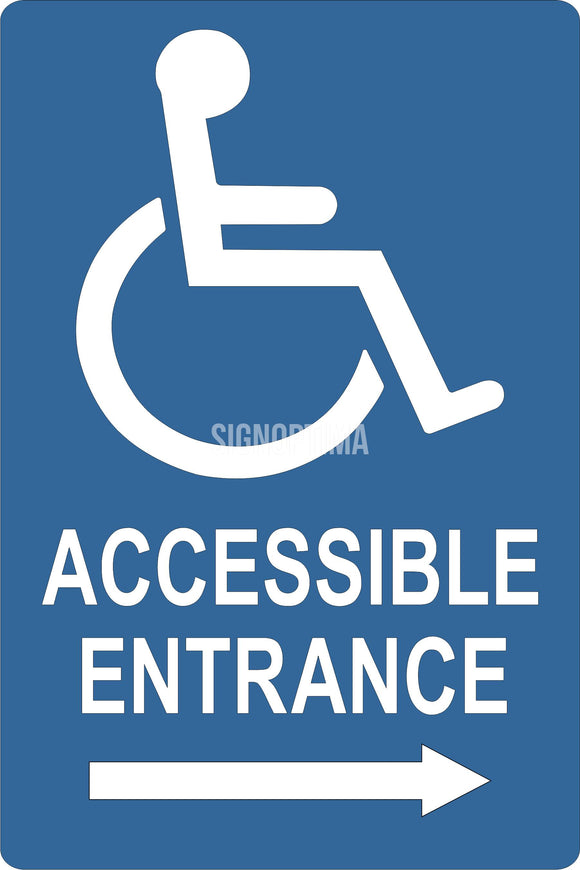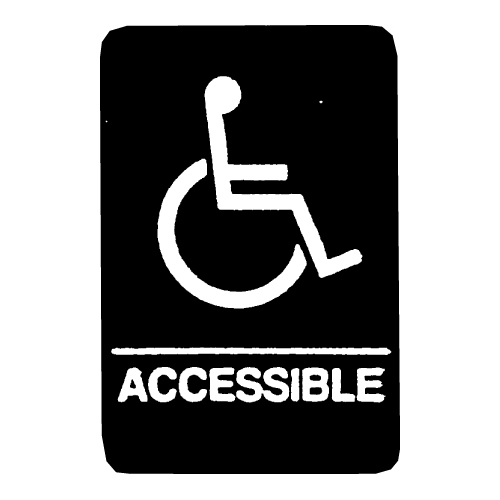The Impact of ADA Signs on Neighborhood Ease Of Access
The Impact of ADA Signs on Neighborhood Ease Of Access
Blog Article
Exactly How ADA Indications Change Spaces for People With Specials Needs
The improvement of spaces via ADA indicators for individuals with disabilities is an extensive testament to the power of availability. By sticking to ADA compliance, atmospheres end up being safe and accessible, with indicators that function crucial aspects like high-contrast shades and Braille, therefore enhancing visibility and comprehension. Past plain capability, these indications add to neighborhood inclusion, supplying a sense of empowerment and belonging. As we look towards future patterns in easily accessible signage, one must take into consideration just how evolving innovations may better transform these rooms. What possibilities and difficulties lie in advance in ensuring these areas continue to be inclusive for all?

Significance of ADA Conformity
Ensuring ADA compliance is not just a lawful obligation however additionally a societal commitment to inclusivity and accessibility. By sticking to the guidelines stated in the Americans with Disabilities Act (ADA), companies show their dedication to developing settings where individuals with impairments can navigate and engage without obstacles. ADA compliance is critical in getting rid of discrimination, promoting equality, and promoting self-reliance for people with handicaps.
Businesses and public institutions profit dramatically from ADA conformity. By ensuring facilities are accessible to every person, companies can draw in a broader customer base, including the 61 million Americans living with impairments.
In addition, ADA conformity is a keystone of global layout, which highlights creating areas that accommodate all individuals, regardless of their abilities. By carrying out compliant signs and functions, organizations add to a more fair culture, where all participants can get involved fully. Ultimately, ADA compliance goes beyond lawful responsibility, symbolizing a societal worth that focuses on empowerment and equivalent possibility for everybody.
Enhancing Navigation and Security
Browsing rooms with self-confidence and safety is vital for people with disabilities, and ADA-compliant signage plays a crucial duty in achieving this objective. These indications are designed with specific features to satisfy the varied demands of people with different impairments, consequently promoting smoother and more secure navigating throughout public and private rooms. By giving clear, standardized information, ADA indications reduce complication and promote a better feeling of self-reliance for individuals that depend on them.
The tactical positioning of ADA indicators makes certain that important details comes to everybody, consisting of those with aesthetic, acoustic, or cognitive problems. For instance, tactile and Braille aspects on signs aid visually impaired individuals independently locate exits, toilets, and other essential locations. In emergency scenarios, ADA signs add to effective discharges by clearly noting fire escape and courses, hence improving safety and security for all owners.
In addition, ADA-compliant signs promote a comprehensive environment by dealing with the special navigation obstacles encountered by individuals with impairments. This not just help in their personal security however also encourages involvement in social activities by promoting equivalent access to civil services and facilities. Eventually, efficient ADA signage transforms rooms into obtainable, risk-free, and welcoming environments for every person.
Features of Reliable ADA Indications
To create reliable ADA indicators, it is imperative to include certain functions that deal with the varied access demands of individuals with disabilities. One essential function is making use of high-contrast shades, which considerably enhance presence for individuals with visual disabilities. The background and text ought to contrast sharply to ensure the information is conveniently noticeable. Additionally, the message must remain in a sans-serif font style, as these typefaces provide clearer readability at a range.
One more necessary feature is tactile aspects, such as elevated personalities and Braille, helping with access for aesthetically damaged people. The elevated characters should go to the very least 1/32 inch over the surface area, enabling easy touch analysis. Braille must be positioned directly listed below matching message, making certain consistency and convenience of navigating.
The positioning of ADA indicators is additionally crucial for their effectiveness. They should be set up at an elevation between 48 to 60 inches from the ground to ensure they are within reach for individuals in mobility devices or those with mobility help. Moreover, indications should lie near toilets, doorways, and lifts, ensuring that crucial details comes precisely when required. By integrating these functions, ADA indications can significantly boost wayfinding and availability for all.
Influence On Community Addition
ADA indicators dramatically add to area addition by ensuring that public spaces are obtainable and navigable for people with specials needs. These indicators, designed in compliance with the Americans with Disabilities Act (ADA), function responsive elements, braille, and high-contrast colors, assisting not just those with aesthetic problems but a varied series of disabilities - ADA Signs. Therefore, they play a crucial role in creating atmospheres where people with impairments can participate completely and independently in neighborhood life

In addition, ADA indications help organizations and businesses fulfill legal commitments, thus preventing possible discrimination lawsuits and boosting their track records as inclusive entities. Ultimately, ADA signs are vital tools in the ongoing effort to build more easily accessible and equitable areas for everyone.
Future Trends in Accessible Signage
The integration of innovative technologies promises to revolutionize how individuals with disabilities engage with their environments. Digital indicators equipped with sensing units and connection can connect with personal gadgets to provide tailored information, such as text-to-speech for visually damaged customers or simplified graphics for those with cognitive handicaps.
Augmented truth (AR) likewise holds considerable possibility. AR applications can overlay electronic info onto real-world atmospheres, supplying individuals with improved navigational help and contextual information (ADA Signs). This can be especially helpful in complex settings like airports or huge public venues where conventional signage may fall short
One more arising pattern is the consolidation of Web of Points (IoT) modern technology to develop a network of interconnected indications. This permits real-time updates and enhanced accessibility, adjusting to changes in the setting or individual needs. Furthermore, with the expanding emphasis on inclusivity, future guidelines might promote much more innovative signage services, making sure universal accessibility and fostering a much more inclusive society for all individuals.
Verdict
ADA indications play a vital duty in transforming rooms for individuals with disabilities by making sure accessibility and advertising independence. Compliance with ADA requirements improves navigating and security with using high-contrast colors, responsive aspects, and Braille. These attributes promote neighborhood inclusion and empower individuals by producing barrier-free atmospheres. The constant evolution of easily accessible signs guarantees additional advancements in inclusivity, ultimately improving the total experiences of individuals with specials needs and enhancing their sense of belonging in community life.
The transformation of rooms via ADA signs for people with specials needs is an extensive testimony to the power of accessibility.To develop reliable ADA indicators, it is vital to incorporate particular features that address the varied ease of access pop over to this site requirements of people navigate to this website with disabilities.ADA signs considerably contribute to neighborhood addition by ensuring that public spaces are navigable and obtainable for individuals with impairments.By helping with the convenience of movement and understanding within public areas, ADA signs cultivate a feeling of belonging and empowerment amongst people with impairments.ADA signs play a vital function in changing spaces for people with disabilities by guaranteeing availability and advertising independence.
Report this page